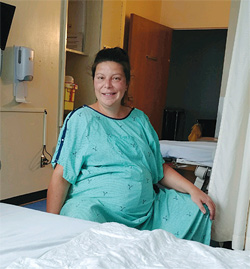Recognizing the start of labour
No one can predict when and how your labour will begin. Most women will recognize labour because of certain telltale signs, such as contractions or their waters breaking. It’s normal at that point to feel excited or anxious.
Passing the mucus plug
The mucus plug, which blocks the cervix during pregnancy, is made of thick, jelly-like substance sometimes tinged with blood. You may lose your mucus plug several days before you give birth or during labour. You can even lose it in several stages.
If you lose your mucus plug, don’t be too quick to jump to conclusions. This doesn’t necessarily mean labour has started. You will need to wait for other signs.
You may also lose your mucus plug without realizing it.
Contractions
For most women, labour begins with uterine contractions. During contractions, your belly grows tight and hard, and you have pain that lasts at least 20 seconds (see Telling the difference between contractions and other abdominal pain).
Many women feel pain in the lower abdomen. For others, the pain is centred in the lower back and spreads to the front. Some women find the pain of contractions similar to menstrual cramps, only stronger.
Every woman will experience contractions in her own way. The sensations may be different for the same woman from one pregnancy to another.
Contractions during labour are regular and grow steadily stronger.
Breaking of the waters (rupture of the amniotic membrane)

![]() When your water breaks, you should go to the hospital or birthing centre, even if you have no contractions.
When your water breaks, you should go to the hospital or birthing centre, even if you have no contractions.
For some women (about one in ten), the breaking of the waters (rupture of the amniotic membrane, or amniotic sac) signals the beginning of labour.
The amniotic membrane is made up of two layers, which are often referred to as “membranes.” The membrane envelops your baby and holds the amniotic fluid that surrounds him. When it ruptures, the amniotic fluid leaks out.
This is commonly known as having your “water break” because the liquid that leaks out is clear like water, although sometimes tinged with a bit of blood. You may only leak a few drops or it may leak enough to wet your bed or your clothes. In some cases, there may be so much liquid that it drips onto the floor.
At the end of pregnancy it can be difficult to distinguish between normal vaginal discharge and amniotic fluid (see Telling the difference between the types of discharge). Generally with amniotic fluid, there will be enough to soak a sanitary pad.
What to do?
When your water breaks, you should go to the hospital or birthing centre, even if you have no contractions.
The staff will make sure your baby is doing well. They will also check whether your membrane did actually rupture, or if you simply have vaginal discharge, which tends to be heavier at the end of pregnancy.
Labour will likely start in the hours after your water breaks. If the contractions still haven’t begun or if you are a carrier of group B streptococcus (also called GBS), labour may need to be induced (see Inducing labour).
Labour: Process by which the baby passes from the uterus to the outside world, primarily through contractions of the uterus.


